St George-the-Martyr, Southwark, Surrey, London
Up to 1834
The parish of St George-the-Martyr, Southwark, had a workhouse on the north side of Mint Street in Southwark originally dating from 1729. It was the subject of a report in An Account of Several Workhouses..., dated October 1731.
THE Master being bred a Dealer in Wool, is very skilful to buy it at the best hand, at Rumney-Marsh in Kent, for 3l. 10s. a Pack, weighing generally about 240l. of which he often makes 7l. 10s. by selling the Mop-Yarn at 7d. ½ per Pound to several Turners in London, together with the Improvements following, of all the Packs he buys.
HE sorts the Wool, and out of about 3000 Weight he has cull'd so much good Wool, as to yield 300 Weight of good Jersey, spun in the House, beside a coarser Sort which serves for Stockings, of which 103 Pair were spun and knit in the House between February and September last; for which unexpected Frugality, the Overseers made him a handsome Present, it being much clearly saved out of Wool bought for Mop-Yarn.
HE has the Skill of whitening his Wool, which recommends his Work to all the Turners that deal with him, and several have gives him 7s. 6d. for a Dozen Pound, when they could buy it elsewhere for 7s.
A Committee appointed by the Vary of the Parish meet every Thursday, to oversee the Management of the House, and pass the Steward's Account of Provisions, which is kept in the same exact Order as some other Houses have fallen into, so that they can scarce be wronged of a Farthing. The House, and all the Offices in it, are kept very clean by the Mistress, who is the Steward's Wife. They have 3 Flesh Days in the Week, and in other Respects fare as other Houses.
PRAYERS are said every Day in the family, and all that are able go to Church, or same other Place of religious Worship, every Lord's Day.
AMONG other Rules for the Government of the House, the Overseers have closed the Orders of the House, (which are generally the same as in other Work-houses) with this:
"That all such Poor as shall duly observe the foregoing Orders relating to Work, shall be entitled to 1d. for every Shilling they earn; and the rest, who do other necessary Business in the Family, such as dressing the Victuals, Nursing, Washing, cleaning the House, and the like, shall also be allowed such Encouragement Money as their Service shall deserve; but if any lay out this Money in Liquors, and disorder themselves, they shall be severely punished."
N.B. It is remarkable, that all the Parishes in Southwark, except St. Thomas's, have set up large Workhouses, for the Reception of their numerous Poor, which are so well regulated, that as fast as there is any Vacancy, Interest is made by the Poor themselves to be admitted; and this Happiness seldom fails, where the Overseers of these Houses are diligent to inspect the Management, and to commit the Direction of them to discreet Masters and Mistresses, as well as to give all reasonable Encouragement to those that acquit themselves with Fidelity.
A new building in Mint Street, probably on the same site, was erected in 1782. Its location is shown on the 1872 map below, by which time it had been taken over by St Saviour's Poor Law Union. At this date, the cramped premises housed males at the west and females at the east. There was a large dining-hall which presumably also served as a chapel. At the South of the site, facing onto Mint Street, were offices and a registrar's office — the civil registration of births, marriage and deaths introduced in 1837 was carried out by poor law unions.
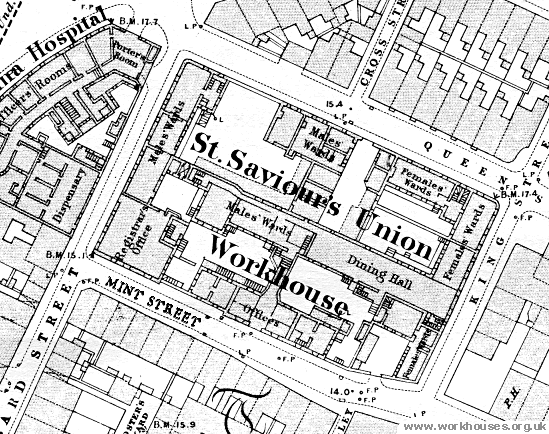
St George-the-Martyr, Southwark, 1872.
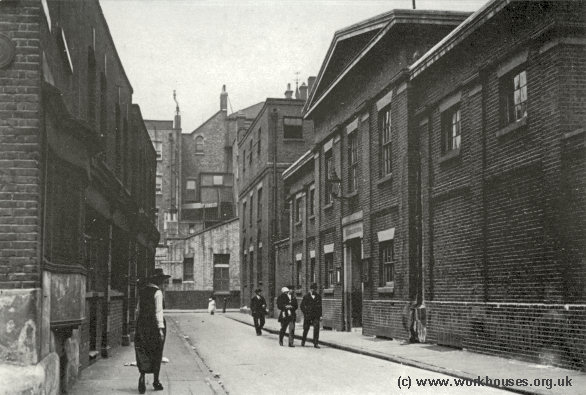
Southwark Mint Street workhouse from the south-east, c.1910
© Peter Higginbotham
After 1834
St George-the-Martyr, Southwark, was constituted as a Poor Law Parish on 28th October, 1835. Its operation was overseen by an elected Board of Guardians, 18 in number. The population falling within the parish at the 1831 census had been 39,769 and the average annual poor-rate expenditure for the period 1832-34 had been £20,642.
In September 1865, St George-the-Martyr was the subject of one of a series of articles in the medical journal The Lancet investigating conditions in London workhouses and their infirmaries. The report revealed a catalogue of appalling conditions in the building.
During our visit to the infirmary wards, fourteen in number, scattered over the entire house, we were accompanied by Mr. Brown, the medical officer and his very intelligent assistant. The official return states that each ward contains almost 500 cubic feet to each bed; but we doubt this statement from our measurement. The efforts made to ventilate the wards, consisting of perforated zinc shafts, extending on a line with the ceiling, with openings in the floor, appeared to us very ineffectual; the wards smelt very musty and suggested a mischievous state of things.
The bedsteads were partly wood, and in some wards iron, on an average six feet in length and two feet six inches in width. The beds of flock were in good canvas cases, as were also the pillows, and the sheets and blankets were moderately clean. The rule of the house is to supply a clean sheet every week, and oftener if required. Towels were in abundance; but the custom amongst the women, not amongst the men, was to wash in the "chamber"—a habit so inveterate that no threats avail to stop it. Air-cushions and macintoshes were found in abundance in the wards, and regularly used.
Each ward had an open fireplace; a lavatory and water-closet in a recess or lobby; in some instances the latter served for two or three wards. In several cases the grossest possible carelessness and neglect were discovered in some of these wards. Take the following in illustration:—Thirty men had used one closet, in which there had been no water for more than a week, and which was in close proximity to their ward; and in an adjoining ward so strong was the ammoniacal smell that we had no doubt respecting the position of the cabinet, which we found dry. In No. 4 ward (female), with 17 beds, the drain-smell from a lavatory in a recess of the room was so offensive that we suspected a sewer-communication, and soon discovered that there was no trap; indeed it had been lost for some considerable time. Apart from this source of contamination of the ward, there were several cases with offensive discharges : one particularly, a case of cancer, which, no disinfectant being used, rendered the room almost unbearable to the other inmates. The absence of the usual decencies and needful cleanliness of the infirmary will at once suggest the class of nurses in charge: for we feel assured that no properly trained nurse would have tolerated such abominations as we witnessed. The number of the sick and infirm amounts to between 200 and 300, all of whom are nursed by pauper nurses, who receive in money from 1s. to 2s. per week, meat and beer daily, and dry tea and sugar. The female nurses are dressed in brown check, and have a marked superiority over the paupers; the male nurses have no distinction. On interrogating some of the pauper female nurses on the subject of their duties, and especially on their mode of washing those who were incapable of doing it for themselves, they admitted that the "chamber" was the favourite utensil, and even defended its use. Intemperance is common amongst them; indeed, so great is the evil that the medical officer considered it prevailed to the extent of 90 per cent. The result of our examination of the different classes of food and drinks was, as is usually the case, very satisfactory. The mode of preparing the food, too, is generally good and moderately cheap; in respect of prices many of the guardians have made excellent bargains for the poor in this season of scarcity: the poor, therefore, in our well-regulated houses are so far better off than the same class of poor in our rural districts; but in many cases the amount of food supplied is really defective, and in St. George's the supply of animal food is not sufficient either for the able-bodied or the sick, unless to the latter class the medical officers specially order a larger quantity. On some future occasion we shall again allude to this subject. In order, however, that our readers may judge for themselves, we subjoin the dietary for the sick, as directed by the guardians, but not ordered by the Poor-law Board.
Full Diet (Male and Female.)
Dinner: Bread, 4 oz. ; broth, 1 pint; potatoes, 8 oz. meat, 4 oz.
Supper: Bread-and-butter, 4¼ oz. ; tea, 1 pint.
Dinner: Bread, 4 oz. ; broth, 1 pint.
Supper: Bread-and-butter, 4¼ oz. ; tea, 1 pint.
The "infirm", at the discretion of the guardians, can have tea for breakfast and supper not exceeding one pint per meal, sweetened with ½ oz. of sugar to each pint of tea each; and with 7 oz. of butter weekly, in lieu of gruel, for breakfast and supper—the ordinary diet.
The salary of the medical officer is 80l. per annum which, with the extras, midwifery, and lunacy, amounts to 150l. per annum: he has to supply all the drugs, even quinine and cod-liver oil The number of sick and infirm now under treatment is 165, but the average is 230. The medical officer visits daily, and is often summoned several times in the day.
For the last three years and a half this house appears to have suffered from various epidemics, and especially from typhus. Many cases are admitted into the house from the neighbourhood; but many are developed in the house, and apparently in this way: The tramp ward for the women is a miserable room, foul and dirty, with imperfect light and ventilation, the floor being simply bedded with straw. Into this open sty the women are passed in, often with little or no clothing; and there, in considerable numbers, they pass the night. There being no watercloset attached, a large can or tub is placed in the room. This is the sole accommodation which the apartment possesses. The master informed us that there is no matron to look after the women, and that the place was really "a den of horrors," in which from twenty to thirty persons passed the night. After a very limited term of occupancy of this place, the women were struck down with fever, the place proving a perfect "fever bed." It is due to the Poor-law Board to state that they have refused to certify this most objectionable room; and we are glad to hear that other and more suitable quarters are being provided for these poor outcasts, who had better sleep in the streets and on door-steps than be entrapped into this manufactory of fever. Nothing more striking than this has come under our cognizance; and it would be very interesting to inquire the cost of this tramp ward to the guardians of St. George-the-Martyr; apart from the amount of the sacrifice of human life, which might form another subject for examination. From what has come within our knowledge here in connexion with the creation of fever, we doubt whether a greater or more flagrant instance of recklessness about human life could be pictured. We may fairly hope it is an exceptional case.
Again, taking up the subject of fever, we learn that during the months of April, May, and June in 1864, there were treated 145 cases of typhus, 130 having been admitted, and 15 occurring amongst the inmates; 12 died out of this number, all adults except one.
In addition to epidemic fever, erysipelas prevailed in the house four months ago, having been brought in from the district. There were 20 cases, and 2 deaths.
This was followed by dysentery to the extent of 50 cases ; but there were no deaths.
To complete the catalogue of infectious diseases, we were told that about a month ago there were 10 cases of scarlet fever, all of which, however, made good recoveries.
The average mortality of the house is 300. Last year the number was 296.
We cannot doubt that, with such a history and so many surroundings, it is our duty to condemn this workhouse, which ought to be removed, and one built better adapted to fulfil its duties to the poor and sick of the neighbourhood.
The outcry that The Lancet articles provoked was a significant factor leading to the passing of the Metropolitan Poor Act in 1867. The Act introduced major changes in the provision of care for London's sick poor and also resulted in the creation of the Metropolitan Asylums Board (MAB).
Despite the its condemnation by The Lancet, the Mint Street site appears to have continued in use until 1920. The site is now mostly a park plus some apartment blocks. The former workhouse buildings have now all been demolished apart from a short stretch of wall at the north side of Mint Street where the main entrance was located.
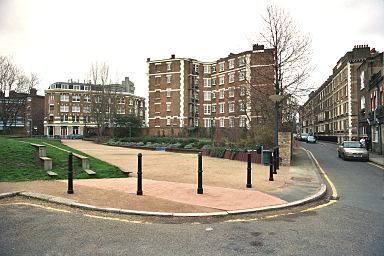
Southwark Mint Street workhouse site, 2004
© Peter Higginbotham
St George-the-Martyr became part of the St Saviour's Union in 1869. The St Saviour's Union was renamed Southwark Union in 1901.
The Mitcham Industrial School
In 1856, St George's Parish erected a large industrial school in the grounds of Eagle House at the west side of the High Street in Upper Mitcham. The building, with an E-shaped layout, was typical of the "barrack" school establishments of the period such as those at Hanwell and Anerley. The building had an Italianate-style administrative centre with an imposing tower above. To each side were three-storey wings, one for boys and one for girls.
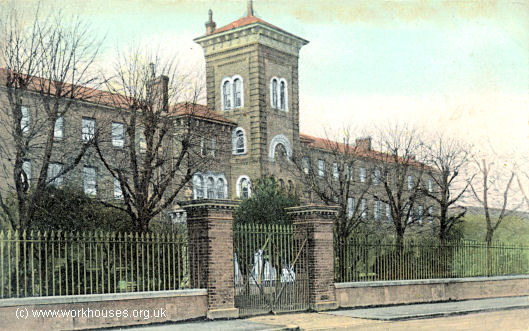
Mitcham School main building from the south-east, c.1910.
© Peter Higginbotham.
The school was sold to the Holborn Union in 1870. Its layout is shown on the 1913 map below.
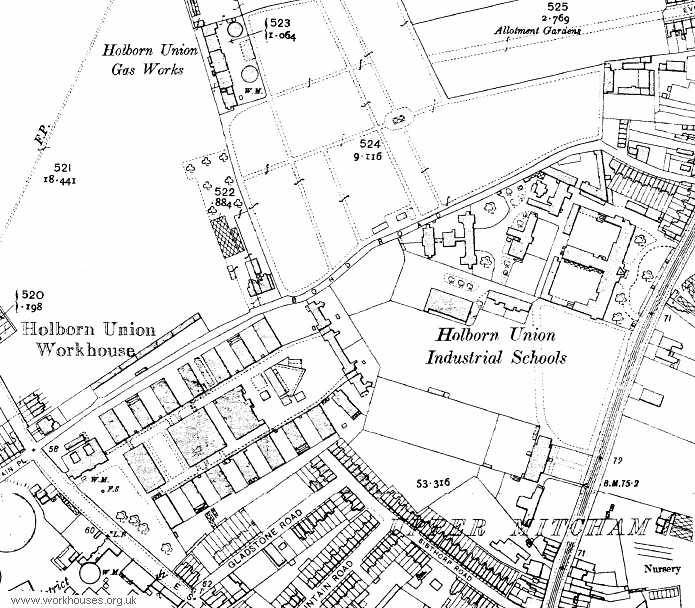
Mitcham School site, 1913
Staff
Inmates
Records
Note: many repositories impose a closure period of up to 100 years for records identifying individuals. Before travelling a long distance, always check that the records you want to consult will be available.
-
The
Ancestry UK
website has two collections of London workhouse records (both name searchable):
- Westminster workhouse records are available on FindMyPast, .
-
London Metropolitan Archives, 40 Northampton Road, London EC1R OHB.
- Guardians' minutes (1835-71)
- Mint Street Workhouse: Admissions and discharges (1852-1910); Births (1835-1911); Deaths (1835-1920); Creed registers (1870-1920).
- Mitcham School: Register of children sent to Mitcham School and South Metropolitan School District (1856-November 1870, missing July 1860-August 1862); Register of children sent to Mitcham School and South Metropolitan School District (March 1867-June 1872); etc. [n.b. LMA files first series of registers under St George the Martyr, and second set under "Southwark Board of Guardians" — no such body actually existed until 1901. Later records are listed under Holborn.]
Bibliography
- Higginbotham, Peter Workhouses of London and the South East (2019)
Links
- None.
Unless otherwise indicated, this page () is copyright Peter Higginbotham. Contents may not be reproduced without permission.


